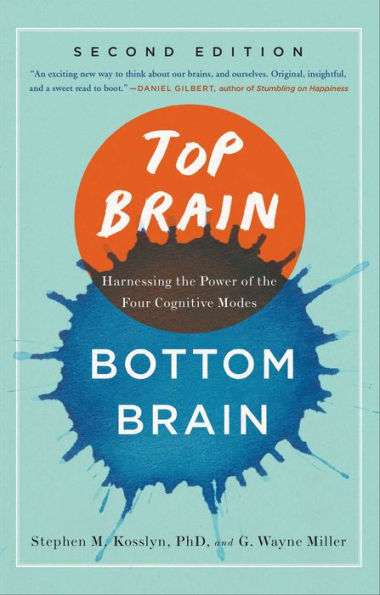One of the world’s leading neuroscientists teams up with an accomplished writer to debunk the popular left-brain/right-brain theory and offer an exciting new way of thinking about our minds.
For the past fifty years, popular culture has led us to believe in the left-brain vs. right-brain theory of personality types. Right-brain people, we’ve been told, are artistic, intuitive, and thoughtful, while left-brain people tend to be more analytical, logical, and objective.
It would be an illuminating theory if it did not have one major drawback: It is simply not supported by science. Dr. Stephen M. Kosslyn, who Steven Pinker calls “one of the world’s great cognitive neuroscientists,” explains with cowriter G. Wayne Miller an exciting new theory of the brain.
Presenting extensive research in an inviting and accessible way, Kosslyn and Miller describe how the human brain uses patterns of thought that can be identified and understood through four modes of thinking: Mover, Perceiver, Stimulator, and Adaptor.
Once you’ve identified your usual mode of thought, the practical applications are limitless, from how you work with others when you conduct business, to your personal relationships, to your voyage of self-discovery.
The second edition of Top Brain, Bottom Brain includes expanded practical applications and highlights how readers can harness the theory to succeed in their own lives.
1114818809
For the past fifty years, popular culture has led us to believe in the left-brain vs. right-brain theory of personality types. Right-brain people, we’ve been told, are artistic, intuitive, and thoughtful, while left-brain people tend to be more analytical, logical, and objective.
It would be an illuminating theory if it did not have one major drawback: It is simply not supported by science. Dr. Stephen M. Kosslyn, who Steven Pinker calls “one of the world’s great cognitive neuroscientists,” explains with cowriter G. Wayne Miller an exciting new theory of the brain.
Presenting extensive research in an inviting and accessible way, Kosslyn and Miller describe how the human brain uses patterns of thought that can be identified and understood through four modes of thinking: Mover, Perceiver, Stimulator, and Adaptor.
Once you’ve identified your usual mode of thought, the practical applications are limitless, from how you work with others when you conduct business, to your personal relationships, to your voyage of self-discovery.
The second edition of Top Brain, Bottom Brain includes expanded practical applications and highlights how readers can harness the theory to succeed in their own lives.
Top Brain, Bottom Brain: Harnessing the Power of the Four Cognitive Modes
One of the world’s leading neuroscientists teams up with an accomplished writer to debunk the popular left-brain/right-brain theory and offer an exciting new way of thinking about our minds.
For the past fifty years, popular culture has led us to believe in the left-brain vs. right-brain theory of personality types. Right-brain people, we’ve been told, are artistic, intuitive, and thoughtful, while left-brain people tend to be more analytical, logical, and objective.
It would be an illuminating theory if it did not have one major drawback: It is simply not supported by science. Dr. Stephen M. Kosslyn, who Steven Pinker calls “one of the world’s great cognitive neuroscientists,” explains with cowriter G. Wayne Miller an exciting new theory of the brain.
Presenting extensive research in an inviting and accessible way, Kosslyn and Miller describe how the human brain uses patterns of thought that can be identified and understood through four modes of thinking: Mover, Perceiver, Stimulator, and Adaptor.
Once you’ve identified your usual mode of thought, the practical applications are limitless, from how you work with others when you conduct business, to your personal relationships, to your voyage of self-discovery.
The second edition of Top Brain, Bottom Brain includes expanded practical applications and highlights how readers can harness the theory to succeed in their own lives.
For the past fifty years, popular culture has led us to believe in the left-brain vs. right-brain theory of personality types. Right-brain people, we’ve been told, are artistic, intuitive, and thoughtful, while left-brain people tend to be more analytical, logical, and objective.
It would be an illuminating theory if it did not have one major drawback: It is simply not supported by science. Dr. Stephen M. Kosslyn, who Steven Pinker calls “one of the world’s great cognitive neuroscientists,” explains with cowriter G. Wayne Miller an exciting new theory of the brain.
Presenting extensive research in an inviting and accessible way, Kosslyn and Miller describe how the human brain uses patterns of thought that can be identified and understood through four modes of thinking: Mover, Perceiver, Stimulator, and Adaptor.
Once you’ve identified your usual mode of thought, the practical applications are limitless, from how you work with others when you conduct business, to your personal relationships, to your voyage of self-discovery.
The second edition of Top Brain, Bottom Brain includes expanded practical applications and highlights how readers can harness the theory to succeed in their own lives.
13.49
In Stock
5
1

Top Brain, Bottom Brain: Harnessing the Power of the Four Cognitive Modes
209
Top Brain, Bottom Brain: Harnessing the Power of the Four Cognitive Modes
209eBook
$13.49
$17.99
Save 25%
Current price is $13.49, Original price is $17.99. You Save 25%.
Related collections and offers
13.49
In Stock

Product Details
| ISBN-13: | 9781451645125 |
|---|---|
| Publisher: | Simon & Schuster |
| Publication date: | 02/13/2024 |
| Sold by: | Barnes & Noble |
| Format: | eBook |
| Pages: | 209 |
| Sales rank: | 81,850 |
| File size: | 4 MB |
About the Author
From the B&N Reads Blog
